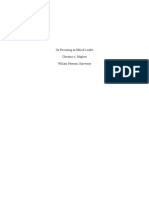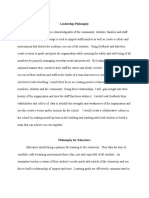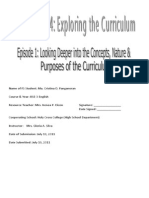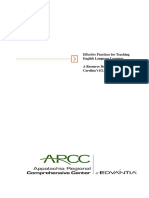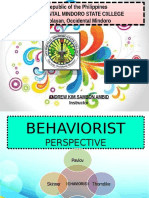T-Tess Six Educator Standards
T-Tess Six Educator Standards
Uploaded by
api-351054075Copyright:
Available Formats
T-Tess Six Educator Standards
T-Tess Six Educator Standards
Uploaded by
api-351054075Original Title
Copyright
Available Formats
Share this document
Did you find this document useful?
Is this content inappropriate?
Copyright:
Available Formats
T-Tess Six Educator Standards
T-Tess Six Educator Standards
Uploaded by
api-351054075Copyright:
Available Formats
Standard 1: Instructional Planning and Delivery.
Each lesson that a teacher creates should meet the state guidelines for possessing strategies that
provide teachings that express content knowledge and lesson delivery that is clear, organized,
standard-driven, evidence based, and differentiated. Teachers should incorporate strategies that meet
the needs of differentiated classrooms like, slowing down lessons, re-teaching content, or using
individual lesson plans. Teachers should add the different learning styles in their lesson plans to ensure
the use of oral, written, graphic, kinesthetic, and or tactile methods are used daily. Teachers should
make content interesting and engaging and set higher standards for students so they are motivated to
learn with a deeper understanding of the content. Teachers should incorporate formative assessments
during lessons to ensure lesson objectives are being met and should also give timely informative
feedback that helps reinforce the students understanding.
Standard 2: Knowledge of Students and Student Learning.
Each teacher should learn who their students are. They should be familiar with their educational and
developmental backgrounds and be able to individualize each students instructional plan. Teachers
should work hard to ensure high levels of learning, social-emotional development, and achievement
outcomes. Teachers should demonstrate this by teaching to their students strengths, and taking
responsibility for their educational growth. They should know and use background information to
engage students in learning. Teachers knowledge should include students prior knowledge, culture,
language, developmental characteristics, exceptional needs, and learning strategies along with
providing resources to support each individual need.
Standard 3: Content Knowledge and Expertise.
Teachers are responsible to know their lesson content well and to demonstrate that to their students by
aligning lessons with objectives and creating activities that are relevant to the state standards.
Teachers should have experience in their subject they are teaching. Lessons should be delivered at
grade level; teachers should report age gaps to leaders. Teachers should also stay knowledgeable to
new changes within their discipline. Lessons should be consistent with the state standards and should
reveal their content expertise by not only adapting instruction but anticipating misunderstandings and
preconceptions to lesson content.
Standard 4: Learning Environment.
Each teacher should be able to provide a classroom that is respectful, accepting of different cultures,
positive, and productive. The classroom itself should be safe and easily accessible to learning
resources. It should be accommodating to all student who have different learning needs. Classroom
routines should be communicated clearly. Routines should establish and reinforce behavior
management. Teachers should provide environments that have high expectations for students, use the
whole class time for learning and be able to flow smoothly from one task to another.
Standard 5: Data-Driven Practice.
Teachers should use many types of analysis to measure student growth while ensuring goals and
objectives are being met. Formative and summative assessments should be used to measure progress.
Goals are set for individuals and for groups. Students should be involved in self-assessments and goal
setting. Teachers should evaluate students progress through many sources of work. This should include
short term and long term collections of data. Teachers should regularly compare their curriculum scope
and sequence with the student data collected to confirm they are on track.
Standard 6: Professional Practices and Responsibilities.
Teachers should hold themselves to a high standard of integrity which ensures they develop as
individuals, engage in leadership opportunities, collaborate with their peers, communicate well with
their stakeholders, maintain professional relationships, and comply with district policies. Teachers
should also possess high standard of integrity and act ethically. Teachers should constantly try to
improve themselves and create action plans to improve and track their improvements. Teachers should
collaborate with each other and provide feedback as well as receive feedback to promote self-
awareness, job embedded professional development, and to improve instructional practices that help
improve student learning. Teachers should help each other. Teachers are expected to advocate for their
You might also like
- Lela LlorensDocument13 pagesLela LlorensAde Perez Otero100% (2)
- T-Tess Self - AssessmentDocument1 pageT-Tess Self - Assessmentapi-336657140100% (1)
- On Becoming An Ethical Leader - FinalDocument8 pagesOn Becoming An Ethical Leader - Finalapi-510869532No ratings yet
- Guided Reading and Writing Lesson Plan ECS 580 Week 3Document6 pagesGuided Reading and Writing Lesson Plan ECS 580 Week 3Jacqueline MedinaNo ratings yet
- Education Leadership Platform Statement 501Document5 pagesEducation Leadership Platform Statement 501api-459428619100% (1)
- Leadership Platform v2Document7 pagesLeadership Platform v2api-413826669No ratings yet
- A Professional Growth Plan Incorporating The STP ProcessDocument3 pagesA Professional Growth Plan Incorporating The STP Processapi-538028309No ratings yet
- Components of SelfDocument4 pagesComponents of SelfManwinder Singh Gill78% (9)
- Getting Started With The Verbal Behavior Approach by Mary Lynch Barbera, RN, MSN, BCBADocument5 pagesGetting Started With The Verbal Behavior Approach by Mary Lynch Barbera, RN, MSN, BCBAautismone100% (5)
- Teachers Obligations N RolesDocument10 pagesTeachers Obligations N RolesNabila Binti AliNo ratings yet
- CST Students with Disabilities: New York State Teacher CertificationFrom EverandCST Students with Disabilities: New York State Teacher CertificationNo ratings yet
- 90 Day PlanDocument6 pages90 Day Planapi-519662536No ratings yet
- Model Didik HiburDocument23 pagesModel Didik Hibursuzzy romilusNo ratings yet
- Tips in TutoringDocument10 pagesTips in Tutoringapi-252821028No ratings yet
- Q W Learning Walk LetterDocument2 pagesQ W Learning Walk LetterChip ChaseNo ratings yet
- Content Validity of Creative Thinking Skills AssessmentDocument10 pagesContent Validity of Creative Thinking Skills AssessmentAndi Ulfa Tenri PadaNo ratings yet
- Ech-480 Professional Dispositions Statement Assessment - Wright ADocument5 pagesEch-480 Professional Dispositions Statement Assessment - Wright Aapi-333094080100% (1)
- Triple e Software 3 - Kahoot-3Document7 pagesTriple e Software 3 - Kahoot-3api-406050331No ratings yet
- Outcome 4 Final Research Paper - Gaming To Improve GrammarDocument10 pagesOutcome 4 Final Research Paper - Gaming To Improve Grammarapi-276174938No ratings yet
- Leadership Style and PhilosophyDocument8 pagesLeadership Style and Philosophyapi-473269684No ratings yet
- Classroom Management SystemDocument7 pagesClassroom Management Systemajextope100% (1)
- Aarsh Colleage Principal EvaluationDocument20 pagesAarsh Colleage Principal EvaluationArya SamajNo ratings yet
- VXCGVDocument24 pagesVXCGVGeorge Aryan Dela VegaNo ratings yet
- FS4 Episode 1Document6 pagesFS4 Episode 1Catherine Magallanes LibaboneNo ratings yet
- Professional Dispositions Statement AssessmentDocument5 pagesProfessional Dispositions Statement Assessmentapi-400765826100% (2)
- Ms 1 A Listening Lesson PlanDocument4 pagesMs 1 A Listening Lesson PlanReham IsmailNo ratings yet
- FS4 Episode 5Document1 pageFS4 Episode 5Neil Patrick FloresNo ratings yet
- Student Work AnalysisDocument9 pagesStudent Work Analysisapi-252982922No ratings yet
- Ten Tips For Classroom ManagementDocument5 pagesTen Tips For Classroom ManagementLízbeth GuillénNo ratings yet
- School Parent Compact 14 15Document2 pagesSchool Parent Compact 14 15Kyle MuellerNo ratings yet
- Getting Started With Microsoft Publisher 2013Document6 pagesGetting Started With Microsoft Publisher 2013AR LONo ratings yet
- Effective Practices For Teaching English Language Learners A Resource Document For North Carolina's ELL Work GroupDocument26 pagesEffective Practices For Teaching English Language Learners A Resource Document For North Carolina's ELL Work GroupJenipher AbadNo ratings yet
- PPSD Superintendent Entry PlanDocument10 pagesPPSD Superintendent Entry PlanWJAR NBC 10No ratings yet
- Learner Profile PDDocument17 pagesLearner Profile PDapi-425909021No ratings yet
- Learning WalksDocument12 pagesLearning WalksrahatvirtualNo ratings yet
- PLC Data Driven Facilitator GuideDocument2 pagesPLC Data Driven Facilitator Guideapi-425909021No ratings yet
- Jquap Maximize Instruction Through Professional DevelopmentDocument5 pagesJquap Maximize Instruction Through Professional Developmentapi-524975964No ratings yet
- Standards For School LeadersDocument45 pagesStandards For School LeadersBayissa Bekele100% (1)
- Daily ReflectionsDocument11 pagesDaily Reflectionsapi-253005231No ratings yet
- TtessDocument1 pageTtessapi-384081691No ratings yet
- Achenjangteachingphilosophy: Unorthodox Medicinal TherapiesDocument2 pagesAchenjangteachingphilosophy: Unorthodox Medicinal TherapiesZZ_14UNo ratings yet
- Tool Validity and ReliabilityDocument9 pagesTool Validity and ReliabilityudupisonyNo ratings yet
- Principal Evaluation From The Ground UpDocument7 pagesPrincipal Evaluation From The Ground Upapi-208210160No ratings yet
- Integrating Differentiated Instruction & Understanding by Design: Connecting Content and Kids, 1st EditionDocument10 pagesIntegrating Differentiated Instruction & Understanding by Design: Connecting Content and Kids, 1st EditionLogan KelleyNo ratings yet
- t2 Induction Plans For Beginning Teachers - Ma 1Document8 pagest2 Induction Plans For Beginning Teachers - Ma 1api-596789776No ratings yet
- Leadership Platform - JonesDocument7 pagesLeadership Platform - Jonesapi-132081358No ratings yet
- Practicum Plan and Campus-Supervised Log1Document15 pagesPracticum Plan and Campus-Supervised Log1api-251400390No ratings yet
- Personal Leadership PlatformDocument8 pagesPersonal Leadership Platformapi-500044547No ratings yet
- ArtifactsDocument45 pagesArtifactsapi-418341355100% (1)
- Ead 529 Curriculum and Professional DevelopmentDocument3 pagesEad 529 Curriculum and Professional Developmentapi-671417127No ratings yet
- Brochure Rubric 1Document2 pagesBrochure Rubric 1Aljhon Cagaanan BacoNo ratings yet
- Social Dimensions of EducationDocument7 pagesSocial Dimensions of EducationPascual La Rosa Jr.No ratings yet
- Case Study: Special Education Cassidy Tiehen May 5, 2021 EAD-519 MiddletonDocument8 pagesCase Study: Special Education Cassidy Tiehen May 5, 2021 EAD-519 Middletonapi-541263096No ratings yet
- Seager B Sped875 m2 Mentor Teacher CollaborationDocument4 pagesSeager B Sped875 m2 Mentor Teacher Collaborationapi-281775629No ratings yet
- Professional Development EssayDocument1 pageProfessional Development EssayKim Xuân TrầnNo ratings yet
- School Budgetary Needs AssessmentDocument6 pagesSchool Budgetary Needs AssessmentShayla WilliamsNo ratings yet
- 90 Day Entry Plan Final-TroutmancDocument9 pages90 Day Entry Plan Final-Troutmancapi-550324608No ratings yet
- Effective Superintendents Effective Boards Finding The Right FitDocument12 pagesEffective Superintendents Effective Boards Finding The Right Fitelmerocampion100% (1)
- Identifying Leader PositionsDocument3 pagesIdentifying Leader Positionsapi-354423377No ratings yet
- Field - Based Internship Planning WorksheetDocument6 pagesField - Based Internship Planning Worksheetapi-206214367No ratings yet
- Designing Effective PDDocument36 pagesDesigning Effective PDaspiredNo ratings yet
- Effective Schools CharacteristicsDocument1 pageEffective Schools CharacteristicsMa Ronielyn Umantod MayolNo ratings yet
- Identifying and Empowering Instructional LeadersDocument6 pagesIdentifying and Empowering Instructional Leadersapi-628625061No ratings yet
- Act Activity 7 Summary PageDocument1 pageAct Activity 7 Summary Pageapi-351054075No ratings yet
- Act Formative AssessmentDocument2 pagesAct Formative Assessmentapi-351054075No ratings yet
- Madeline Hunter Lesson CycleDocument1 pageMadeline Hunter Lesson Cycleapi-351054075No ratings yet
- Lesson Plan Scientific ProcessesDocument2 pagesLesson Plan Scientific Processesapi-351054075No ratings yet
- Six Classroom RoutinesDocument1 pageSix Classroom Routinesapi-351054075No ratings yet
- Modifications and Accommodation1Document1 pageModifications and Accommodation1api-351054075No ratings yet
- Act Making Content Comprehensible 5-8Document1 pageAct Making Content Comprehensible 5-8api-351054075No ratings yet
- Act Making Content Comprehensible 1-4Document1 pageAct Making Content Comprehensible 1-4api-351054075No ratings yet
- 33Document3 pages33wdadafdawfd100% (4)
- Autism: CharacteristicsDocument2 pagesAutism: CharacteristicsSarvesh JaiswalNo ratings yet
- Strategic Communication Plan - ASOSDocument38 pagesStrategic Communication Plan - ASOSEllie BootonNo ratings yet
- Transactional AnalysisDocument15 pagesTransactional Analysisshital_vyas1987No ratings yet
- Peer Observation 1Document3 pagesPeer Observation 1HamadNo ratings yet
- Conflict ManagementDocument37 pagesConflict Managementjonathan_carretasNo ratings yet
- Communication StylesDocument9 pagesCommunication StylesNelson OmukhangoNo ratings yet
- Consumer Buying BehavioronSamsung MobileDocument25 pagesConsumer Buying BehavioronSamsung MobileHarpreet Sharma100% (2)
- EMOTIONAL and Behavioral DisordersDocument3 pagesEMOTIONAL and Behavioral Disordersjonacambri06No ratings yet
- Zero To Three 2014 Executive Functions PDFDocument11 pagesZero To Three 2014 Executive Functions PDFJorge SilvaNo ratings yet
- What Is Conflict?Document15 pagesWhat Is Conflict?DooNo ratings yet
- Assessment of Leadership Performance4Document72 pagesAssessment of Leadership Performance4trudiddleNo ratings yet
- Theories of Leadership: Trait ApproachDocument5 pagesTheories of Leadership: Trait ApproachManagement KnowledgeNo ratings yet
- Interview QuestionsDocument4 pagesInterview Questionsapi-259164366No ratings yet
- Secondary Data MotivationDocument3 pagesSecondary Data MotivationJasgeoNo ratings yet
- Behaviorist PerspectiveDocument27 pagesBehaviorist PerspectiveKhiem AmbidNo ratings yet
- Group DynamicsDocument29 pagesGroup Dynamicsmahfuzah100% (1)
- Intro To The Special IssueDocument14 pagesIntro To The Special Issueapi-318577028100% (1)
- Mcqs 200-400Document19 pagesMcqs 200-400Noman AnserNo ratings yet
- Therapeutic Approaches: Indian School MuscatDocument10 pagesTherapeutic Approaches: Indian School MuscatNidhee SharmaNo ratings yet
- Merideth Chapter 1Document19 pagesMerideth Chapter 1Nasrun Abd ManafNo ratings yet
- Prof - Dr.Aung Tun Thet LFH#16 7/24/2020Document50 pagesProf - Dr.Aung Tun Thet LFH#16 7/24/2020tinmaungtheinNo ratings yet
- Leadership Self AssessmentDocument5 pagesLeadership Self Assessmentapi-284269118No ratings yet
- F1 Discipline Without PunishmentDocument5 pagesF1 Discipline Without PunishmentMohit SahniNo ratings yet
- Systematic Desensitization and ExposureDocument24 pagesSystematic Desensitization and ExposureMariya ChristyNo ratings yet
- BUS201 202 Tutorial 01 SolutionsDocument3 pagesBUS201 202 Tutorial 01 SolutionsPui YanNo ratings yet
- Philosophy of Action (PDFDrive)Document187 pagesPhilosophy of Action (PDFDrive)MartaNo ratings yet


